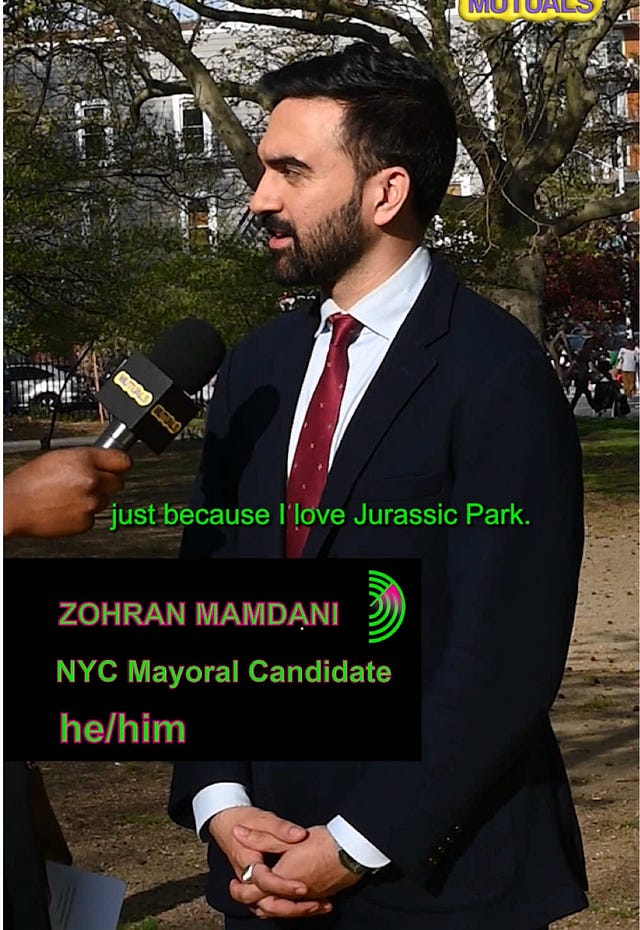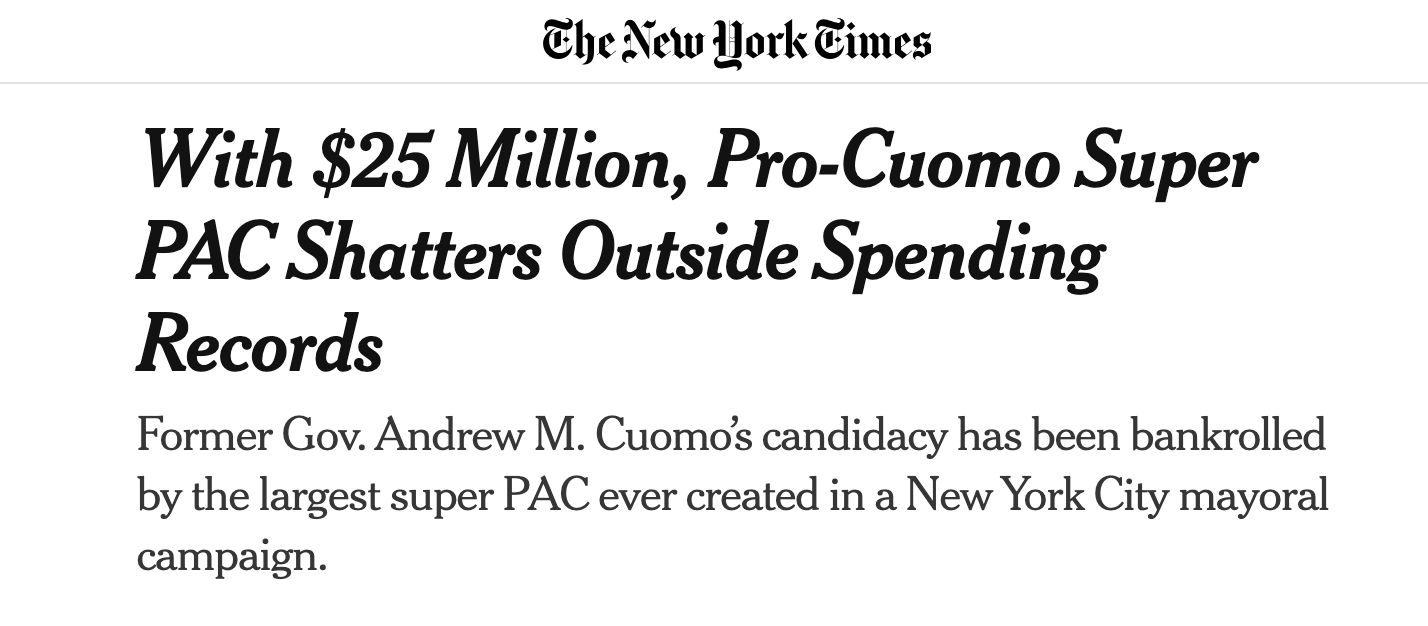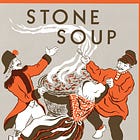Let's Talk About... Why You Should Run Your Film's Marketing & PR Campaign Like Mamdani Ran His NYC Election Campaign
After a stunning victory in the NYC primary, this month's free Substack covers the strategies Zohran Mamdani implemented for victory & helps filmmakers apply the tactics to their impact campaigns.
In this month’s free post, putting all politics aside, I’m breaking down how Mamdani upended the election playbooks and how filmmakers can do the same thing with distribution playbook spending less than the studios do.
But first… my film DARUMA is available on Amazon Prime… for free.
So if you haven’t watched it yet, and you’d like to, check it out on Prime for no cost to you and support this indie filmmaker.
Marketing & PR for Indie Films is a reader supported publication: if you’d like to upgrade your subscription for $5/mo or $50 a year, or to learn more about marketing and PR for your #IndieFilm and work with me, click here.
Mamdani’s campaign was impact producing at its finest. - KLA Media Group
Fun Fact for Film Geeks:
Zohran’s mother is acclaimed Indian director Mira Nair (Monsoon Wedding, Vanity Fair).
Unless you’ve been living under a rock these past few days, you might have heard the news that Zohran Mamdani won the NYC primary for mayor.
His victory has been called “stunning”, a “political lightning bolt”, and a “seismic shift". So how does someone like Mamdani beat the establishment’s incumbent who is vastly better funded and better endorsed (ie - the studio movie to your indie film) and go on to achieve such incredible results?
I’m going to draw the comparison that Mamdani ran his campaign in a way that all indie filmmakers should be running their film’s marketing and PR campaigns and break down the strategies he used in this month’s free newsletter.
Tactic #1: He Started YEARS Ago
This victory did not happen overnight, and neither does the success of any film. I constantly speak with filmmakers who are waiting for “a thing” to happen before they do anything and that’s (one of) their biggest problem.
During the COVID shutdowns in 2020, my film was completely derailed: it was impossible to even discuss what regrouping would look like because no one knew. But what I did know is that I had TIME on my hands. Lots and lots of TIME. And I used that time to build my social media following, supporters and fans, and connect with people so by the time the film was ready to screen, we already HAD an audience.
THAT’S how we sold out our screenings, not the other way around. It wasn’t because of the location we screened at or the festival or anything else. We built that following, person by person.
So stop thinking that you need the film or the festival or whatever else to get the audience: it’s the other way around. And if the only thing you have to work with at the moment is TIME, use it and use it wisely.
My favorite proverb is that the best time to plant a tree was twenty years ago. The next best time is today.
Tactic #2: Mamdani KNEW Who His Audience Was & Where to Reach Them
Mamdani conducted his own focus groups in the fall of 2024 and it became clear that the thing that resonated with most of them was the high cost of living in New York City, an issue that he made central to his campaign. Doing this early allowed him to develop consistent messaging and plot his path over the next year for his campaign.
While the rest of the Democratic field was talking about crime and disorder, Mamdani made “affordability” the buzzword of the campaign by promising free buses, free child care, and a rent freeze on rent-stabilized apartments. - NY Magazine
Tactic #3: Mamdani Targeted Media Outside of the Establishment
reports that candidate Cuomo stuck to the traditional playbook during his campaign, getting endorsements from party and union leaders, stuck primarily to television ads and traditional media interviews. The Bulwark notes that Mamdani interviewed with the outlet twice, while Cuomo’s camp declined to even reply to invitations to interview with them on FOUR occasions. Mamdani on the other hand, leaned into non traditional outlets like Gaydar.
Which in turn generated organic support like this:
Each of the next videos became viral sensations, including one in which he took the “polar plunge” into the frigid waters off Coney Island in a suit to call attention to his plan to “freeze the rent.” In another, he talked up rising halal-cart prices to highlight affordability — never mind that the traditional Democratic strategy guide would suggest a Muslim candidate avoid anything associated with halal. The video was picked up by Eater and other food media.
- NY Magazine
You know who doesn’t usually cover politics? Food media. But darn it, this kind of creativity got his message OUT to people… people who would VOTE for him.
So yeah, if you’ve been sweating that your film isn’t in the trades or on Good Morning America… stop. There are a billion ways to get PR for your film and get your messaging out into the world and I daresay more meaningful ways.
DM me if you want to chat about how we can work together and check out these other posts I’ve written regarding the “new media landscape”:
Tactic #4: Mamdani Enlisted a Grassroots Effort to Spread Campaign Awareness
Early on, Mamdani’s team began a grassroots campaign to gain supporters from around the world who would campaign on his behalf for free. This is essentially another arm of PR: third party validation.
I’m showing my age here, but when I first started out we’d have to literally measure how big an article was in print and multiply the cost of what a similar ad would cost i the same publication by a factor of 4, 5, or 6X depending on the outlet we were working with to determine what the value of the PR placement was. That’s because the value of PR over advertising is worth 3, 4, 5, 6X whatever, because it’s got third party validation.
Mamdani has enthusiastic supporters around the country and the world, ones he reached through a booming social media presence that inspired people to campaign authentically on his behalf for free.
Additionally, his messaging was on point and authentic.
Tactic #5: Mamdani Engaged
Yes, Mamdani was successful on social media but he wasn’t just on social media. He campaigned, he got out there, he met with people, he walked the length of Manhattan. When else have you seen a politician get out of their ivory towers and engage? This is the difference between luckily going viral and building a coalition of supporters.
Tactic #6: Mamdani Threw the Old Playbook Out
As you can see Mamdani didn’t have all of the usual things one thinks they need to have to win:
Money
Big name supporters and endorsements
Traditional advertisements
A reliance on legacy media.
In short, his team ripped that playbook to shreds… and won.
And these are all the things indie filmmakers think they need to succeed too. While they help, they’re not a shoe-in to guarantee success.
What Can Filmmakers Learn From This Given The Broken Distribution Landscape for Indie Film?
Mamdani’s campaign was impact producing at its finest and filmmakers can take away so many lessons from how he ran his campaign and apply it to the new distribution model.
I’m sure there’s a million more nuggets to glean from this and analysts all over the country are salivating at the opportunity to poke holes in this approach but what this team did to drive this campaign toward success echoes many of the things I tell the filmmakers I work with to do, including:
Stop Waiting to be Picked
If you wait for someone to pick you and lift you up, you will be waiting for a long time. This is what I wrote about in one of my most popular posts, The Film Soup style of making film.
Stop Relying on Legacy Media
So many filmmakers think that getting an appearance on a large morning show or an announcement in the trades will carry them across the finish line. It’s important yes (and flipping cool when it happens) but it’s not the only thing standing between you and success. It’s not.
Stop Relying on Festivals Alone
Yes, getting into festivals is fun and amazing and really important but it is NOT the thing gatekeeping you from success. You have to do this and build a team who will help you. Just screening in or playing in a festival alone will not be the panacea you think it is for your career.
You MUST Create a Multi-Pronged, 360 Degree Campaign for Your Film
That’s why this newsletter is called marketing AND pr for indie films. I work deeply in both fields because both fields, while vastly different, go hand-in-hand.
It’s not enough to rely on social media or PR or digital marketing or screening in festivals to net you the results you want to see from your film. Mamdani didn’t win because he went on one particular podcast, or made one particular social media video: it was ALL of it. Collectively.
You’ve got to put together a robust marketing campaign that not only encompasses multiple touch points in a sustainable manner, because you’re going to be in bed with your film MUCH longer than you think. This is why when I work with clients, I always try to do an engagement of several months, because I can do my best work with more time.
And most importantly of all:
Know Your Audience
If you don’t know who you’re making the movie for, you can’t possibly know how to reach them so work on that first, and work backwards from there.
Want to Work With Me?
Click here to set up a one-hour consultation where we’ll go over everything for you film and develop a plan of execution. I work with clients on a one-off basis or on a retainer basis and can scale to meet your needs.
Marketing & PR for Indie Films is a reader supported publication: if you’d like to upgrade your subscription for $5/mo or $50 a year, or to learn more about marketing and PR for your #IndieFilm and work with me, click here.
Kelli McNeil-Yellen is a twenty year marketing and PR pro who finally made the leap to indie filmmaking with her award-winning Slamdance film DARUMA, now available on platforms. Learn more about DARUMA here. To work with Kelli, click here.

















